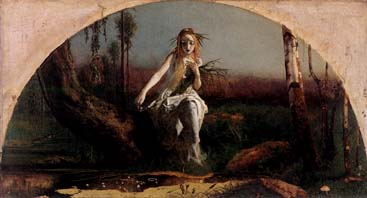
Oil on canvas with an arched top, approximately 27 x 49 inches. Manchester City Art Galleries, Manchester, England.

Oil on canvas with an arched top, approximately 27 x 49 inches. Manchester City Art Galleries, Manchester, England.
Although Arthur Hughes may casually allude to Redgrave's painting in his Ophelia (1852) with the trunk of the tree and the bank of the stream, the resemblance ends there. Hughes depicts Ophelia as a sickly, pale, almost girlish figure who looks down into the water and idly drops blossoms into the stream. Elaine Showalter's distaste for the work is obvious; the painting "shows a tiny waiflike creature--a sort of Tinker Bell Ophelia--in a filmy white gown, perched on a tree trunk by the stream. The overall effect is softened, sexless, and hazy, although the straw in her hair resembles a crown of thorns." Ophelia is a "juxtaposition of childlike femininity and Christian martyrdom" (84-5). But then perhaps Hughes, like most Victorian men, preferred his women childlike, ill, and therefore dependent, as Bram Djistra suggests as he evaluates the painting: we find Ophelia "at the edge of the brook where Shakespeare placed her. In a state of madness and anguish, she has crowned herself with reeds as she watches the flowers she drops in the water float away in anticipation of her own imminent fate. She is emaciated and tubercular and therefore has all the requisite attributes of the icons of illness. Consumptive fever has heightened the contrast between the pallor of her skin and her red lips and the deathlike shadows around her eyes. In the issue of The Art Journal in which the engraving . . . was first published, an enthusiastic commentator remarked on Hughes' singular success in bringing a 'look of vacancy' into Ophelia's 'sweet, child-like face'" (43).
Harry Rusche, Emory University, Atlanta, GA
This page was last revised: January 26, 1998